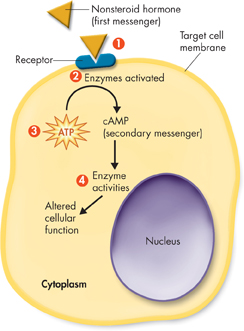Nonsteroid Hormones Nonsteroid hormones generally cannot pass through the cell membrane of their target cells.  Nonsteroid hormones bind to receptors on cell membranes and cause the release of secondary messengers that affect cell activities. Figure 34–3 shows the action of nonsteroid hormones in cells.
Nonsteroid hormones bind to receptors on cell membranes and cause the release of secondary messengers that affect cell activities. Figure 34–3 shows the action of nonsteroid hormones in cells.
A nonsteroid hormone binds to receptors on the cell membrane.
The binding of the hormone activates enzymes on the inner surface of the cell membrane.
These enzymes release secondary messengers such as calcium ions, nucleotides, and even fatty acids to relay the hormone's message within the cell. One common secondary messenger is cAMP (cyclic AMP), which is produced from ATP.
These secondary messengers can activate or inhibit a wide range of cell activities.
Steroid and nonsteroid hormones can have powerful effects on their target cells. It is therefore especially important to understand the ways in which the endocrine system regulates their production and release into the blood.

FIGURE 34–3 Nonsteroid Hormones Nonsteroid hormones bind to receptors on a target cell membrane and cause the release of secondary messengers that affect cell activities.
d34.1 Assessment

-
Review What are the two components of the endocrine system?
Explain Explain the difference between endocrine and exocrine glands.
Compare and Contrast How are hormones and prostaglandins similar? How are they different?
-
Review Explain how steroid hormones act on a cell.
Explain Explain how nonsteroid hormones act on a cell.
Apply Concepts Use what you learned in Chapter 7 about how materials cross cell membranes to explain the actions of steroid hormones and nonsteroid hormones.
Apply the Big idea
What are the advantages of having both a nervous system and an endocrine system?

Table of Contents
- Formulas and Equations
- Applying Formulas and Equations
- Mean, Median, and Mode
- Estimation
- Using Measurements in Calculations
- Effects of Measurement Errors
- Accuracy
- Precision
- Comparing Accuracy and Precision
- Significant Figures
- Calculating With Significant Figures
- Scientific Notation
- Calculating With Scientific Notation
- Dimensional Analysis
- Applying Dimensional Analysis




